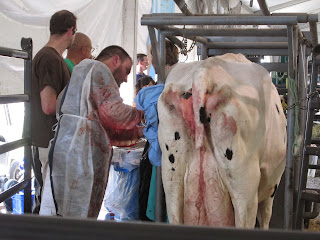 |
| Vets operate on the cow during the 2014 State Fair to deliver her calf. |
The veterinarians pulled out a stillborn calf. The audience members had been on the edge of their seats for more than an hour, wondering how this drama was going to end.
Their collective sound of pain told the story.
It was Dairy Day at the 2014 New York State Fair, that glorious 12 hours to celebrate all that is great about milk, cheese, ice cream and yogurt.
Thousands of people were on the fairgrounds watching milkshake making contests, trying out yogurt parfaits, tasting great New York cheeses and visiting the Empire State’s fabulous dairy cattle.
They also had filed in and out of the Dairy Cow Birthing Center to watch the beginning of the milk cycle -- the miracle of a calf’s birth. It was the second year for the birthing center and a huge hit at the fair.
But this day was a little different. Life played out in front of hundreds of people in the birthing center at about 3 or so that afternoon.
A dairy cow owned by Walnut Ridge Dairy in Lansing, Tompkins County, was ready to give birth. People packed the bleachers and seats to witness the birth.
Each day, three cows would give birth to calves in the center. Adults and children alike ooohed and aaahed as the cute little Holsteins slipped into the world. The mother cow would produce milk from giving birth and from there, she would be milked daily to provide all of us delicious milk to drink or dairy products to eat.
But on Dairy Day, of all days, things didn’t go as planned for this one cow.
“What’s going on?” I asked a lady on the bleachers as I sat down, a few minutes after the drama had begun.
“She’s having problems,” the lady said of the cow. “They’re not sure what’s wrong.”
After watching for a while, I heard Steve Palladino, a partner in Walnut Ridge Dairy, and others on the scene thought either she had a stillborn calf or possibly there were twins on the way.
A bunch of veterinarians came in. They reached inside the cow’s birth canal to see if they could grab the calf and pull it out. That effort failed.
Palladino, nervous for his cow, told the packed house what was going on. People asked questions and Palladino and others tried to answer as best they could.
“My main concern was for the cow,” Palladino said.
Eventually, it became obvious to the veterinarians that a Caesarian section would have to be performed on the cow. Jessica Ziehm, executive director of the New York Animal Agriculture Coalition which runs the birthing center, said this definitely was not planned, but it shows what real life is like on a farm.
The C-section was performed. Spectators were warned in advance that they might want to leave if they couldn’t stomach what was being done. I was sitting right in back of the cow and I have to say, the entire operation was shielded pretty well from view so those watching really couldn’t see anything objectionable.
"I was a nervous wreck," Palladino said. "It's bad enough your cow is going through this but in front of 600 to 700 people?"
“Awwwwww,” the audience said in unison when it heard the outcome.
The cow’s incision was sewn up. The audience was told they would keep an eye on her to be sure she was healing well.
Palladino said at that time she would be able to have more calves and remain a productive member of the Walnut Ridge dairy herd.
But, it was not to be. When checking up on the cow in July, I was told she had been sold to slaughter.
A heart-wrenching decision, to be sure. Palladino said the cow never made much milk after the stillborn birth.
A farmer has to weigh the costs when considering his herd -- does he want to use a lot of feed to keep a cow going if that cow doesn’t produce milk the farmer can sell?
Ziehm said dairy farms are businesses and “at the end of the day they must make decisions that allow them to keep feed in front of the cows, the lights on and bills paid.”
“She did not come into milk or produce enough milk after she calved to justify keeping her in the herd,” Ziehm said. “This is always a difficult decision for a dairy farmer as they have thousands of dollars invested in raising her, as well as the cost of the surgery. So this is not only a tough call emotionally as this is an animal that was raised and cared for from birth on the farm, it’s a significant financial loss as well.”
Palladino said the decision was rough, but one that had to be made.
"Ninety percent of cows that have had C-sections are bred back," Palladino said. "She healed fine, but she didn't come into milk well. This doesn't normally happen."
So in late February or early March -- Palladino couldn't remember exactly -- the cow was sold.
Yes, the Dairy Cow Birthing Center and all dairy farms are real life, folks.
No comments:
Post a Comment